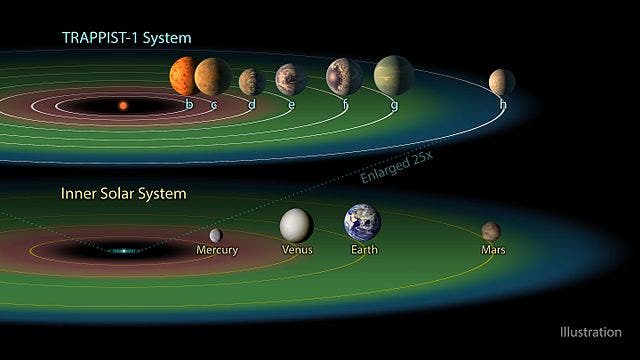If there’s any life in the Trappist-q system, it’s likely that it won’t be limited to only one planet, a study from Harvard University says.

Image credits NASA, ESA, and G. Bacon (STScI) / Wikimedia.
With NASA’s announcement of the seven exoplanets in the Trappist-1 system, three of which lie in the habitable Goldilocks zone and could have liquid water on their surface, the hope of witnessing the discovery alien life got re-ignited for a lot of people.
And we might get more new friends than we’ve thought: a new study published by Manasvi Lingam and Avi Loeb at Harvard University suggests that the habitable planets in the Trappist-1 system are close enough that microbes could hitch a ride from one world to the others via rocks.
Their theory is that when meteorites or other space bodies hit one of these three habitable worlds, the force of the impact could propel material into space which might find its way to one of the neighbors. Microbes sheltering in these chunks of rock could then ‘seed’ life on its new planet, a process referred to as panspermia. It may sound far-fetched, but it’s actually one of the ways we think life could have appeared on Earth — through microbes blown over from Mars in the wake of a huge impact.
Free travel
To test their theory, the team created digital models of how life could move between the planets starting from patterns in species immigration between different islands on Earth. Their results suggest that between the habitable planets in Trappist-1, life has a 1,000 times greater likelihood of transfer compared to that estimated between Earth and Mars. It’s mostly thanks to the fact that the planets are tidally locked in tight orbits around the stars — meaning a short commute for germs between them. Once life settles on one planet, it’s very likely to spread on the others, the authors say.
“These planets are similar to islands on the surface of the Earth, and there are studies of the immigration of species from one island to another,” Loeb explained for Gizmodo.
“We used the same model to illustrate that the likelihood is very high for transfer of life.”

Image credits NASA/JPL-Caltech.
The final check for the theory of panspermia on Trappist-1 will be to find atmospheres around the habitable planets. In the absence of atmospheric cover water won’t stay liquid on the surface, making it unlikely that life could evolve on the planet and almost impossible for it to immigrate from the neighbours. Loeb says that the next order of business is to monitor the planets as they transit in front of the star and measure the dip in light to see if it’s indicative of atmospheres. After that, finding out the atmospheres’ composition to see if they have what we consider the “building blocks of life” — such as oxygen or CO2.
“We can roll the dice three times in this system compared to Earth, which is the only planet where we know life exists in the solar system,” Loeb said. “So at least you have three chances.”
Fingers crossed.
The full paper “Enhanced interplanetary panspermia in the TRAPPIST-1 system” has been published in the journal Astrophysics.



